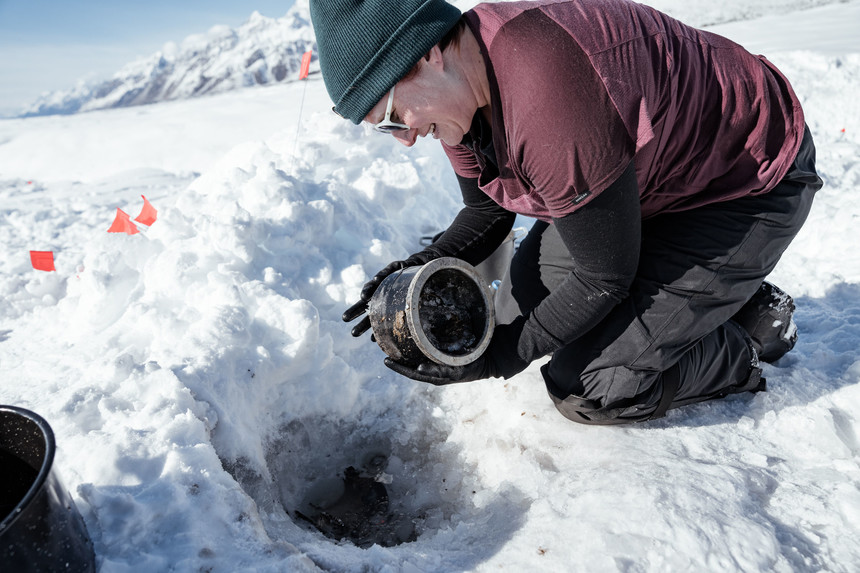
FISM News, Bethany Roberts
[elfsight_social_share_buttons id=”1″]
A team of explorers led by Griffin Post discovered a decades-old cache of abandoned cameras and mountain gear on the Walsh Glacier in Yukon’s Kluane National Park.
The team announced their findings on Oct. 27, bringing historians, scientists, and the public exciting news to a story that has all the twists, drama, and “eureka” moments of a hit book.
Pre-WWII explorers hit icy conditions
Explorers Bradford Washburn and Robert Bates had left the valuable cache behind during their travels to the remote southeastern Yukon wilderness in 1937 to climb Mount Lucania.
Prior to their expedition, bad weather conditions had covered the Walsh glacier in deep, unfathomable slush which was “cut to ribbons by dozens of new crevasses,” Washburn wrote in The Alpine Journal. Once the explorers discovered this, the extreme conditions made it impossible to get down the glacier alive without a very long hike.
More than 100 miles later, the men made it to safety. Along the way, the haul of cameras and gear became too heavy to carry and the explorers left it behind.
Moving glacier carries treasure
While reading “Escape from Lucania,” a book about the men’s expedition written by David Roberts, Post had the idea to go on a treasure hunt of sorts for the lost gear. Post and his 7-person team found the remnants more than 12 miles away from the estimated original drop 85 years after Washburn and Bates had left their gear behind.
On the sixth day of Post’s venture, they were ready to pack it up and try again some other time. Half of his crew had already flown out and the weather conditions were getting dicey; but thanks to the ribbons cut into the glacier from surges, Dr. Dora Medrzycka, a postdoctoral fellow at the University of Ottawa, had one more theory to try.
Due to the changing landscape, the team could not just return to the exact spot the gear was dropped. Most glaciers move at a constant speed (slowly) from year to year; however, the Walsh glacier is a surging glacier, meaning it moves quickly for a period of a year or two. Since the 1930s, the Walsh glacier has surged twice, during which it moved more than 32 feet per day.
“Surging glaciers … have those short periods of intense activity and this irregular behavior that really makes it hard to reconstruct the movement of these glaciers over long time scales,” Medrzycka explained to CBC News.
“Based on that idea, I essentially extrapolated the glacier movement and came up with a new estimate of where the cache could be — and it turned out to be pretty spot on,” she said.
Two anomalies in the ice led Medrzycka to an educated guess on where the items may be – the next day, the team found the cache.
“We literally had an hour before we were going to leave when we started to find parts of their gear and remnants of their trip that was indisputably theirs,” Post said of the expedition. “It was so surreal. You’re kind of in disbelief, and you’re like, ‘Oh my gosh — we were right! This exists!'”
Post and his team found part of Washburn’s aerial F-8 camera, the format that he would become known for later in life. They also recovered two motion picture cameras that still had film, old climbing gear, tents, and even cooking items.
“It was just the full array of gear from what they were using in the 1930s,” said Post.
Not only was the trip a great success, but they also retrieved data that will help the scientific community. Medrzycka’s understanding of glaciers and the data they pulled from the glacial anomalies will help us understand how the glacier develops and behaves.
“We can now better understand the change in the dynamics on Walsh glacier and potentially be able to better predict how this specific glacier might change in the future,” Medrzycka said.
“They have all this information of how this glacier has behaved over the last 85 years — which is a pretty cool contribution to science,” Post said.
The discovered gear is currently with conservators at Parks Canada. They are working to preserve the artifacts and treating the cameras in hope of recovering some of the images from the film.
Teton Gravity Research supported Post and his team. The media company showcases extreme sports and plans to release a film about the team’s journey on the Walsh glacier.
